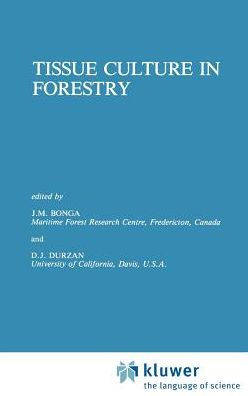Tissue Culture in Forestry
2. IMPORTANCE OF NITROGEN METABOLISM 2. 1. Range of naturally occurring nitrogenous components in forest trees 2. 2. Gene expression and mapping 2. 3. Metabolic changes in organized and unorganized systems 2. 4. Nitrogen and nutrition 2. 5. Aspects of intermediary nitrogen metabolism 3. NITROGEN METABOLISM IN GROWTH AND DEVELOPMENT 3. 1. Precultural factors 3. 2. Callus formation 3. 3. Cell suspensions 3. 3. 1. Conifers 3. 3. 2. Acer 3. 4. Morphogenesis 3. 4. 1. Nitrogen metabolism of natural embryos 3. 4. 2. Somatic embryogenesis 3. 4. 2. 1. Sweetgum (Liquidambar styraciflua) 3. 4. 2. 2. Douglar-fir and loblolly pine 3. 4. 3. Organogenesis 4. OUTLOOK 11. CARBOHYDRATE UTILIZATION AND METABOLISM - T. A. Thorpe 325 1. INTRODUCTION 2. NUTRITIONAL ASPECTS 3. CARBOHYDRATE UPTAKE 4. CARBOHYDRATE METABOLISM 4. 1. Sucrose degradation 4. 2. Metabolism of other carbon sources 4. 3. Hexose mobilization and metabolism 4. 3. 1. Cell cycle studies 4. 3. 2. Growth studies 4. 3. 3. Organized development 4. 4. Cell wall biogenesis 4. 4. 1. Primary cell walls 4. 4. 2. Cell wall turnover 4. 4. 3. Secondary cell walls 4. 5. Carbon skeleton utilization 5. OSMOTIC ROLE 6. CONCLUDING THOUGHTS 369 12. THE USE OF IN VITRO TECHNIQUES FOR GENETIC MODIFICATION—FOREST TREES - E. G. Kirby 1. INTRODUCTION 2. IN VITRO SELECTION 2. 1. Natural variation 2. 2. Induction of variation 2. 3. Selection techniques 2. 4. Plant regeneration 2 . • 5. Applications x 3. SOMATIC HYBRIDIZATION 3. 1.
1101003702
Tissue Culture in Forestry
2. IMPORTANCE OF NITROGEN METABOLISM 2. 1. Range of naturally occurring nitrogenous components in forest trees 2. 2. Gene expression and mapping 2. 3. Metabolic changes in organized and unorganized systems 2. 4. Nitrogen and nutrition 2. 5. Aspects of intermediary nitrogen metabolism 3. NITROGEN METABOLISM IN GROWTH AND DEVELOPMENT 3. 1. Precultural factors 3. 2. Callus formation 3. 3. Cell suspensions 3. 3. 1. Conifers 3. 3. 2. Acer 3. 4. Morphogenesis 3. 4. 1. Nitrogen metabolism of natural embryos 3. 4. 2. Somatic embryogenesis 3. 4. 2. 1. Sweetgum (Liquidambar styraciflua) 3. 4. 2. 2. Douglar-fir and loblolly pine 3. 4. 3. Organogenesis 4. OUTLOOK 11. CARBOHYDRATE UTILIZATION AND METABOLISM - T. A. Thorpe 325 1. INTRODUCTION 2. NUTRITIONAL ASPECTS 3. CARBOHYDRATE UPTAKE 4. CARBOHYDRATE METABOLISM 4. 1. Sucrose degradation 4. 2. Metabolism of other carbon sources 4. 3. Hexose mobilization and metabolism 4. 3. 1. Cell cycle studies 4. 3. 2. Growth studies 4. 3. 3. Organized development 4. 4. Cell wall biogenesis 4. 4. 1. Primary cell walls 4. 4. 2. Cell wall turnover 4. 4. 3. Secondary cell walls 4. 5. Carbon skeleton utilization 5. OSMOTIC ROLE 6. CONCLUDING THOUGHTS 369 12. THE USE OF IN VITRO TECHNIQUES FOR GENETIC MODIFICATION—FOREST TREES - E. G. Kirby 1. INTRODUCTION 2. IN VITRO SELECTION 2. 1. Natural variation 2. 2. Induction of variation 2. 3. Selection techniques 2. 4. Plant regeneration 2 . • 5. Applications x 3. SOMATIC HYBRIDIZATION 3. 1.
219.99
Out Of Stock
5
1

Tissue Culture in Forestry
420
Tissue Culture in Forestry
420
219.99
Out Of Stock

Product Details
| ISBN-13: | 9789024726608 |
|---|---|
| Publisher: | Springer Netherlands |
| Publication date: | 06/30/1982 |
| Series: | Forestry Sciences , #5 |
| Edition description: | 1982 |
| Pages: | 420 |
| Product dimensions: | 8.27(w) x 11.69(h) x 0.24(d) |
From the B&N Reads Blog
